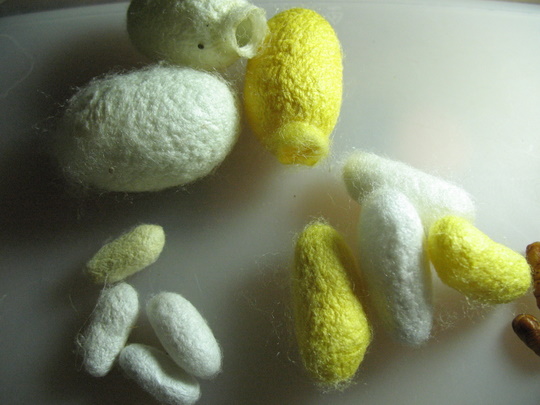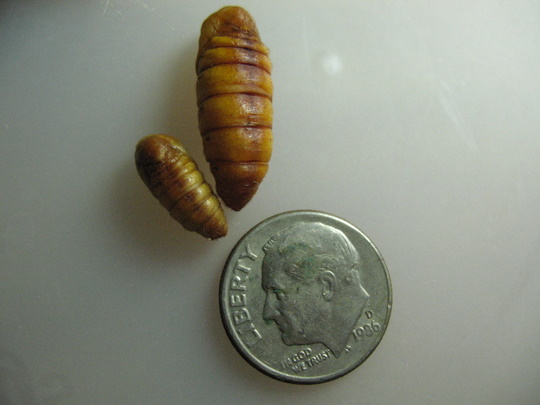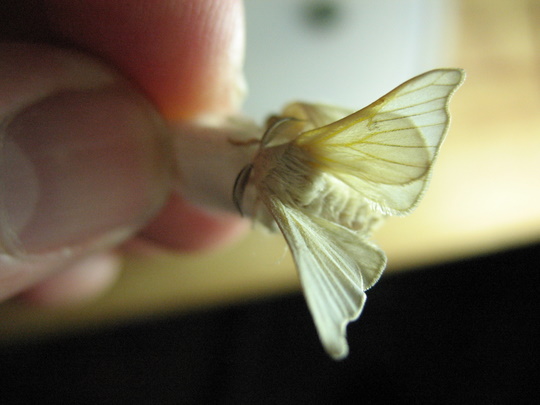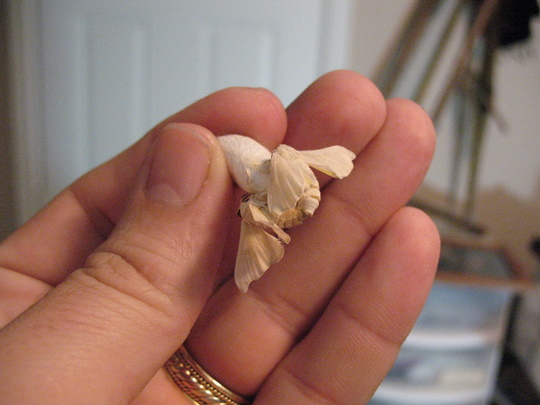Trimoulters
I am raising a Thai strain of silkworms. This spring, I had one good-sized group, and they all made moderately sized cocoons – except for one, which turned out tiny. The summer group, I will admit, got a little bit neglected; I moved during the middle of their cycle, and so they sometimes got not enough food, or old leaves because I couldn’t find the new ones near my new house… you get the idea. Poor little red-headed step-child worms.
So – some of them decided that life was tough, and they would cocoon early. They spun up in the fourth instar, making TINY but perfectly-shaped cocoons. My friend Eika explained that these are called trimoulters, and they are typically caused by feeding over-matured leaves.
Now – these are a naturally small strain. Chihuahua puppies are never going to grow up to be German shepherds – but the trimoulters are *freakishly* small. Here’s a comparison of normal Thai cocoons, hybrid Chinese cocoons, and the trimoulters.
and here’s a comparison of the normal (smallish) Thai pupa, and the trimoulter pupa
And, in a move that should surprise no-one, they hatch out as freakishly small moths. They’re SO CUTE. Like pinchums-widdle-cheekses cute.
Despite being tiny, they are breeding vigorously. I’m curious to see what will come of it – and whether the eggs will be visible.





I don’t comment much, but I love your dedication to your art. Thanks for sharing these photo’s. The tiny cocoon is similar to my mid season leaf, as in it has a different and unique quality in the way it dries to mature leaves.
Do the tiny trimoulters produce a different kind or quality thread / silk?
Wow, maybe you’ve just come up with a new strain of moths for apartment-dwellers! 😀 😉
Thanks!
I honestly don’t know about the quality of the silk – it seems natural that it would be significantly finer, but I haven’t had enough of them to experiment with yet. Maybe if I get a bunch with the next batch I’ll give it a try. So many of the techniques rely on specific characteristics of the cocoons – I don’t know if these would even have enough weight to unwind properly.
Have to just repeat the sentence…..
“poor little redheaded stepchild worms.”
Yep. Made me smile that time too.
T
LOL the tiny creatures look vigorous enough, and just as keen on mating as any other Bombyx moths. They have very good wings!
*takes a container of her own moths and tries to compare sizes*
*fails*
At least I can see that the cocoon is smaller than my smallest cocoon (one of my silkworms spun up too early into its 5th instar; I bet I’m going to get a tiny male moth.)
I’m wondering if your micro-moths are going to live shorter than the others – they have less food supply to be sure.
It seems like they would have less reserve of fat, but also like they would *need* less, with their smaller size.
My friend Michele who had some similar tiny cocoons (from the same strain) said that hers had normal-looking full-size eggs, just fewer of them.
I had a tiny male last year that lived only 3 days instead of the usual 5 to 7 for my strain. But he was very vigorous while he lived. Mated and bred all right.
Well, you’ll see the eggs pretty soon. 🙂
Food
You said Thai and I saw the small cocoon. I thought it was food. All ours are ok… They eat the same mulberry?
Re: Food
Yup, they eat the same mulberry. In their native land, they might eat a different one – some of the southeast Asian mulberries have little leaves – but if they’re raised commercially, they probably plant some variety of M. alba.